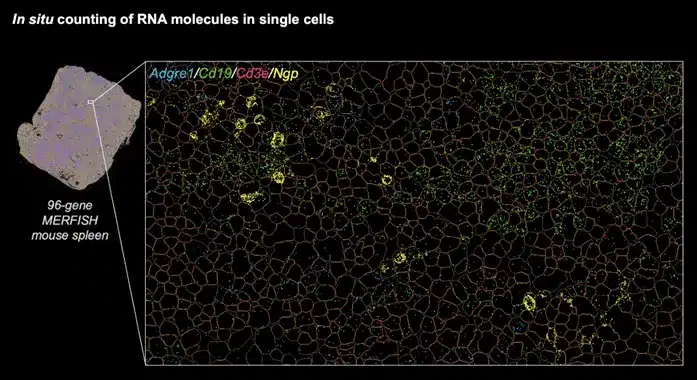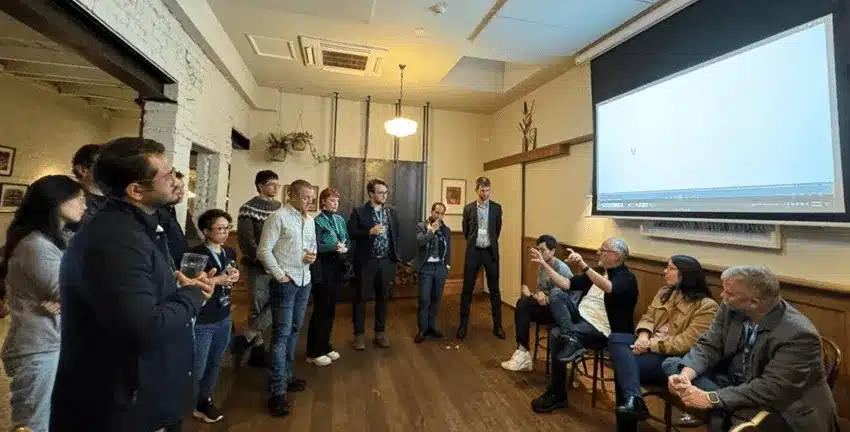On Wednesday, June 5th, Vizgen and Integrated Sciences had the privilege of hosting the inaugural MERSCOPE® User Group Meeting in collaboration with the Walter and Eliza Hall Institute of Medical Research (WEHI). The event was filled with engaging presentations from leading researchers, providing a fantastic opportunity for the Vizgen and Integrated Sciences team to connect with the Australian Spatial Genomics research community and dive deep into the world of MERSCOPE.
Below are highlights of select customer talks presented at the MERSCOPE® User Group Meeting.
Raymond Yip (WEHI)
Presentation Title: High-Resolution Molecular Profiling of Tissue Microenvironment Using the MERSCOPE® Platform
Raymond shared his team’s recent achievements in using MERFISH to study the bone marrow microenvironment. His research revealed how multiple myeloma differentially remodels stromal components to facilitate tumor cell expansion. As a facility manager of the MERSCOPE, Raymond also provided valuable tips and tricks for delivering a successful MERFISH experiment, covering everything from panel design and sample preparation to data quality checks and bioinformatics considerations.

Mengbo Li (Chen Lab at WEHI)
Presentation Title: Cell Type Co-localization and Cell Type-Specific Microenvironment Analysis on Spatial Transcriptomics Data
Mengbo introduced Scider, a Bioconductor R package for cell-type co-localization and cell type-specific microenvironment analysis on spatial transcriptomics data. Scider automatically defines regions of interest (ROIs) using the spatial density of different cell types based on network analysis. This allows for examining cell type co-localization and composition patterns within each ROI, providing a local description of the cellular microenvironment for the cell type of interest. The package also enables differential expression analysis within each cell type across diverse tissue contexts. Scider is publicly available at GitHub.

Chamikara Liyanage (Pal Lab at Olivia Newton-John Cancer Research Institute)
Presentation Title: Profiling Immune Stromal Cell Network in Breast Tumor Microenvironment
Chamikara discussed the role of regulatory T cells (Tregs) during breast cancer progression using spatial transcriptomics profiling of the breast tumor microenvironment (TME). His research aims to uncover the complex and dynamic role of Tregs in modulating immune responses, contributing to immune evasion and disease progression. By mapping receptor-ligand interactions at a spatial level, the team hopes to identify key pathways and mechanisms through which Tregs exert their immunosuppressive effects. This deeper understanding could reveal novel therapeutic targets to disrupt these interactions and enhance anti-tumor immunity.

Other Notable Presentations
- Lucas Tobar (Stacker Lab at The Peter Maccallum Cancer Centre)
- Hieu Nim (Murdoch Children’s Research Institute)
Informatics Session Chairs
- Prof. Alistair Forrest (Harry Perkins Institute of Medical Research)
- Pradeep Rajashekhar (WEHI)
- Xiao Tan (Nguyen Lab at University of Queensland)
- Sayak Mitter (Field Application Scientist Team Lead, Vizgen Inc.)
- Thaddaeus Teo (Field Applications Scientist, Vizgen Inc.)
We concluded the day with a panel discussion on “Mapping the Future of Spatial Genomics,” featuring:
- Prof. Alistair Forrest (Harry Perkins Institute of Medical Research)
- Anna Trigos (The Peter Maccallum Cancer Centre)
- Raymond Yip (WEHI)
- Paul Rasmussen, VP of Sales APAC, Vizgen Inc.

The first MERSCOPE® User Group Meeting at WEHI was a huge success, providing valuable insights and fostering connections within the spatial genomics community. A big thanks to members of the WEHI (Daniela Zalcenstein, Raymond Yip) and Integrated Sciences team who helped organize the meeting. We look forward to more such interactions and continued advancements in this exciting field.
Stay tuned for more updates and future events!